| Columns Retired Columns & Blogs |
Thank you.

I figured it was coming, but it wasn't until just after I'd returned from the Audio Engineering Society's 2016 International Conference on Headphone Technology—held last August in Aalborg, Denmark—and was writing up my report and summary on the event for InnerFidelity.com (footnote 1) that I knew for sure: Headphones are about to change . . . a lot.
I'd like to take you on a little ride into the future of headphones, but first we'll have to go back to the past, for some context. Until 1970 or so, headphones were mostly used in professional recording studios, audiology labs, broadcast studios, and the like. Consumers didn't use them much. Stax's first electrostatic earspeakers appeared in 1960, and slowly gathered a few fans among audiophiles, but that market niche was very small. In 1970, when Koss introduced the Pro4AA dynamic headphones, a few consumers began to take notice. I was one of them. With my paper-route money, I bought a pair of Pro4AAs in 1972, so I could listen to Pink Floyd at night as my little brother slept in the bunk above.
Then, in 1979, with the introduction of the Sony Walkman, consumers for the first time began using headphones in large numbers. Of course, their attention was mostly on the Walkman itself—headphones were mere accessories to that device. It would take something much bigger for headphones to become a viable product in the minds of most consumers.
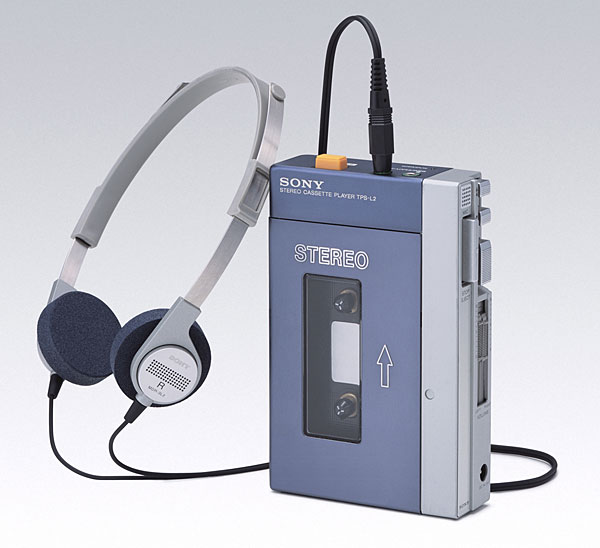
By 1990, little had changed—headphones remained hung on the accessories rack, next to the cables and adapters. But headphones did begin to appear in high-end audio. In Stereophile, Corey Greenberg fawned over Grado's nifty SR60 model ($69), and Stax's pricey electrostatic headphones sold reasonably well among serious audiophiles who needed to keep the noise level down at night.
Many will say that enthusiasm for high-end headphones really began when I founded the sales and manufacturing company HeadRoom, in 1992, and started building a variety of portable and home headphone amplifiers for consumers. But I'd say it began with the coming of the Internet and, a few years later, the online HeadWize headphone forum. Enthusiasm for headphones as a hobby began with online camaraderie, and continues to this day in the virtual town squares of head-fi.org, head-case.org, superbestaudiofriends.org, r/headphones on Reddit, and elsewhere.
Back then, for the most part, audiophiles were reluctant to accept headphones as high-end transducers. They had a point: The headphones of that era didn't sound very good. It would be some time before the sounds of headphones began to rival those of high-end speakers. In fact, we might not quite be there even today.
Headphone geeks made a lot of noise online, but their numbers were slow to grow. Nonetheless, manufacturers became aware of the small but growing market they represented, and—likely due to the remarkable ability of hardcore enthusiasts to spread advice via the Web—began to improve and introduce products for enthusiastic listeners. While this was a time of slow, steady growth in premium headphones costing ca $250–$400, this market niche remained of secondary concern to manufacturers focused on cheap consumer products, expensive pro-audio gear, and special-purpose headphones.
Bottom line: Until the 2000s, the only really strong force driving headphones was portable players. And there, the attention was not on the headphones but on the players, as they morphed from cassette to CD to MP3.
Then, two big things happened.
In 2001, Apple introduced the iPod, and instantly made every preceding portable music player seem clunky and outdated. The focus of buyers' awareness was still on the player, but a few years later, Apple's "silhouette" ad campaign seemed to subconsciously attract consumers' attention to the dancing white wires of the iPod's earbuds. Not only was your physical-media player no longer cool, your stupid foamy-puff, on-ear headphones weren't, either.
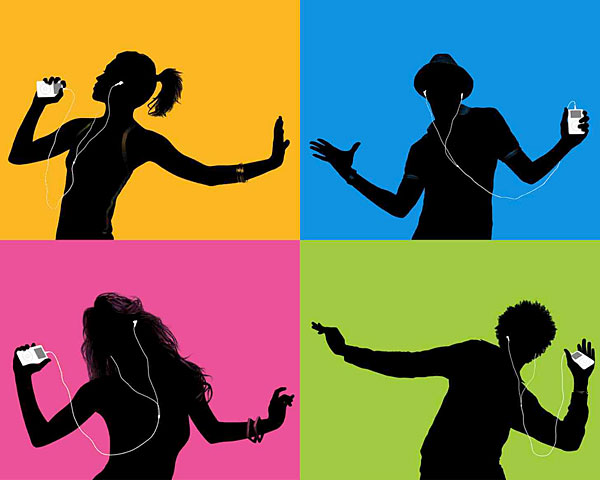
Then, in about 2006, Noel Lee, Head Monster of Monster Cable, got together with Jimmy Iovine and Dr. Dre to produce the first Monster Beats by Dre headphone model. A massive guerrilla marketing campaign ensued, and sports photographers found ample opportunity to snap pics of superstars with headphones slung around their necks, providing millions of dollars' worth of free advertising as fans ate up the images. The kids went wild—cans were cool—and it turned out that a large proportion of consumers were suddenly willing to spend $300 on headphones: easily ten times more than they'd have thought of spending just a few years before. Finally, consumers had awakened to the idea that maybe they ought to think about buying a pair of decent headphones, and Beats began to dominate the headphone market. Unfortunately, the sound quality of the first Beats models was far from decent.
The last ten years have seen a feeding frenzy around consumers' willingness to shell out healthy wads of cash on headphones made by a plethora of new headphone manufacturers: AIAIAI, AudioFly, House of Marley, SMS, Sol Republic, and Soul, to name just a few. The rapid rise of the smartphone, which has put a music player in nearly every pocket, added more blood to the water. Prices rose, and manufacturers enjoyed higher margins of profit—but to remain competitive and relevant, they also had to improve product styling, comfort, reliability—even sound quality. As a result, progress in all aspects of headphone performance has been far more rapid in the last ten years than in the preceding decades.
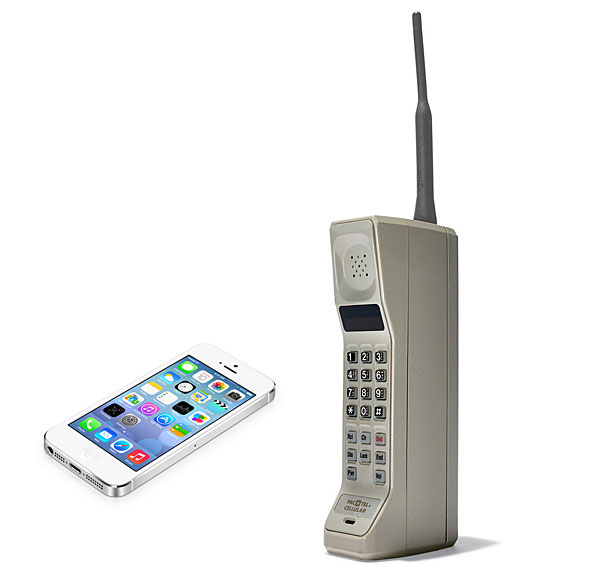
Which brings me to today. Headphones now have strong cultural momentum. Consumers know they need a pair, and perhaps multiple pairs, depending on their use: sweat-proof for fitness, noise-canceling for travel, wireless for portable convenience, etc. Some makers have focused on specific applications: Bose on noise cancelers, Jaybird on sports headphones, and Focal in the premium category. Beats remains the 800-lb gorilla in the room, however, with extraordinary dominance in the various headphone submarkets. According to the market-research firm NPD Group, Beats' sales revenues in 2015 dominated the markets: 46% of Bluetooth headphones, 49% of fitness models, and a whopping 60% of premium headphones (which NPD defines as headphones retailing for more than $100). Bottom line: Headphones are big money makers, which means that manufacturers are highly motivated to make the next cool headphone model.
Everything I've said so far describes what you see out there every day. But headphones have an inner meaning—of what they are and could be to those who design and desire them. The sounds you hear through headphones are not added to your natural acoustic environment, but replace it with a new acoustical space that contains the audio from your music and movies. The problem is that headphones don't sound at all like a natural acoustic environment—all the sound is inside your skull. Headphone designers have always known that if they could crack the nut of making headphones sound like speakers—that is, as if the sounds were coming from outside your skull—it would mean big money.
That is a very hard nut to crack, but it hasn't stopped manufacturers from trying. AKG, in their K1000, and Stax, in a number of models, have hung large planar drivers as far from the ears as possible, to mimic the effects of speakers. Gaming and home-theater companies have put multiple drivers in each earcup, to direct sound at the ear from multiple angles. None of these methods works convincingly.
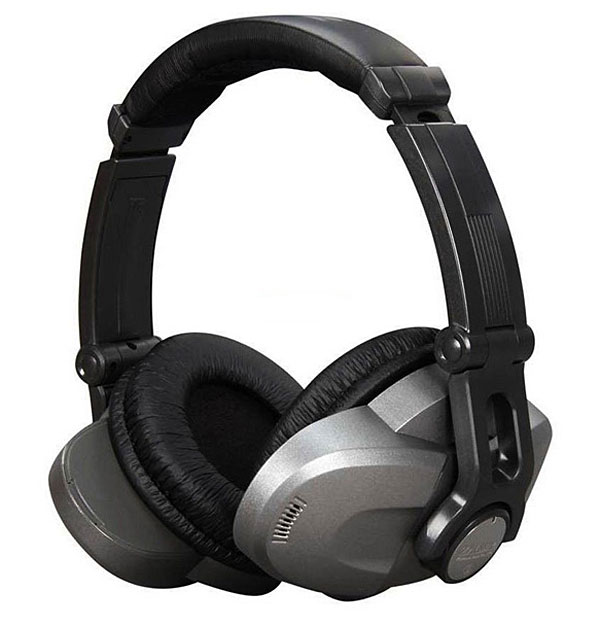
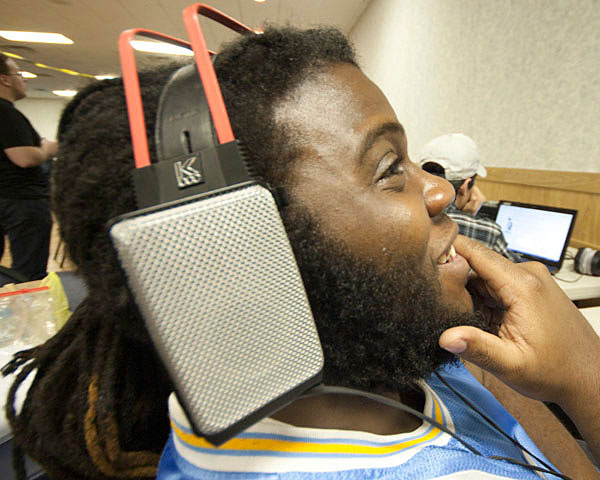
The only commercially available system that convincingly takes sound out of your head is the Smyth Realiser A8. This system is custom-tuned to the response of your own ears: microphones are placed in your ears, to pick up the sounds of calibration signals played through the speakers of your surround-sound system. This is one of two keys to creating, through headphones, convincing external localization of sounds: having it tuned to the anatomy of a listener's own ears by measuring that listener's unique and specific head-related transfer function (HRTF).
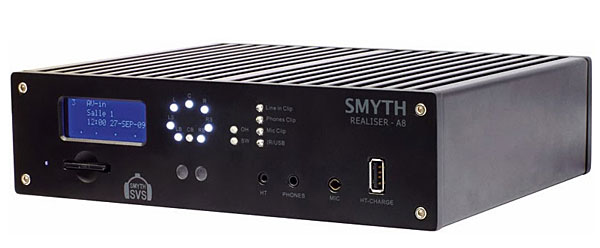
The HRTF is a set of a few dozen to a few hundred frequency-response measurements taken at various angles around the head. Traditionally, this has been done with the listener sitting in an anechoic chamber with his or her head stabilized in one position. A loudspeaker is then moved through various angles of azimuth and elevation around the listener's head, with measurements taken at each position. The process is time-consuming and expensive, but when it's done, and digital signal-processing (DSP) filters for that listener have been developed from the data captured, the result can be a convincingly immersive sound.
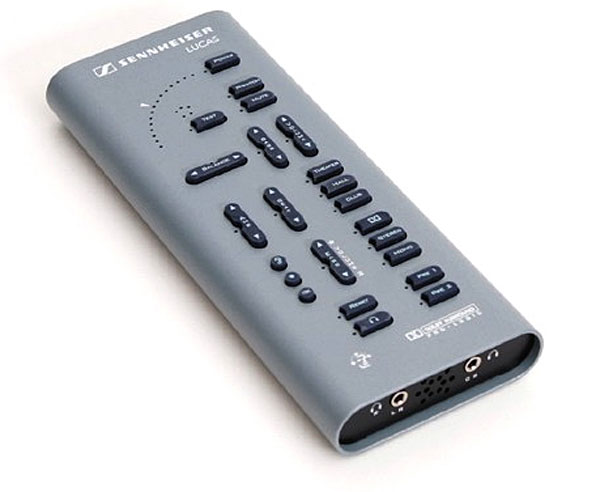
The other key technology required to use headphones to create a believable virtual sonic landscape is to add head-position tracking. Then, when you move your head, the acoustic image remains in place in the virtual room, and doesn't move along with your head. The Smyth Realiser has a head tracker mounted on the headphones. Using input from the tracker, the Realiser adjusts the HRTF in DSP so that, as you turn your head gently from side to side, the positions of the virtual speakers presented to you through the headphones remain fixed in the real-world space around you. Adding head tracking to personalized HRTFs is the holy grail of virtual audio via headphones.
So we have two key ingredients for the growth of the headphone market:
1) A rabid, wallet-opening strength of desire for headphones on the part of consumers, giving manufacturers lots of money to invest in product development. (Headphones are pretty high-margin products—there are lots of profit dollars to work with.)
2) A clear path for the future development of headphones with virtual-audio technology.


No mention of binaural??

The traditional "binaural" is merely a party trick that happens to work for a few people. What Tyll is talking about here is "Binaural 2.0", where instead of the binaural cues being pre-embedded in the recording, and completely static, the cues are computed on-the-fly, adapted to the shape and size of your head and ears, and to your hearing, plus it's adapted to the motion of your head and body, so the location stays fixed.
In other words: It's merely a much more convincing binaural than what you've seen before, and one that can be synthesized for other media than headphones; using things like beamforming speaker arrays, you will be able to project sound to points in a 3d space in your room.

Headphone designs today are similar to Auto Designs of the early 1900s -- just starting out.
We Audiophiles are the early adopters, enjoying the incredible versatility and cost advantages of personal/portable High-End Audio devices.
This "fresh" group of Engineers will launch us into a new "Domain" of accessibility.
It's an exciting time to be watching this un-fold, it's like the Future is "Now"! Phew.
Thanks for taking the time for this effort, your group of lads are "Five" Stars!!!
Of course we'll need Bob Katz to keep producing "A" level recordings and we'll need to discourage the horrible stuff aimed at Radio Station Play lists. I'm kinda thrilled to consider the idea that we'll be using VR to enjoy the Detroit Symphony from any Beach we happen to be sitting on.
This is Exciting Stuff!
Tony in Michigan

I believe millions of Sennheiser 414s and 424s, AKG K140s and K240s, Koss Pro 4AAAAs and other quality phones were bought by music lovers before the advent of the Sony Walkman!

Gordon Holt of Stereophile recommended several headphones well before the Koss's and Sennheisers. Given that stereo has been with us for 60-plus years now, and given that 4 and 5 channel have been around for a long time too - and yet stereo is still dominant in hi-fi (especially headphones), I don't expect much to change. Users will adopt more DSP's for this or that, but the ultimate realism (binaural) is already several decades old, so there's hardly a necessity to improve on that. Recording for speakers, and then developing "realism generators" to undo that to sound better on headphones - an exercise in futility. Better to include a sub-track on the media with the binaural mix, etc.

Since you're describing it as "several decades old": Binaural as you know it - embedded into a recording - has issues. Severe issues
The first one being that they're static - when we get positional cues in real life, we do not only by processing the ITD and ILD, but we do moving our head about to figure out how it changes when we do - a pure binaural track simply cannot do this.
The bigger elephant in the room is that they're recorded using a normative HRTF, and the illusion falls completely apart if your ears (including the ear canal) are the wrong shape or size compared to what is assumed in the dummy head recording. It will get even worse if your head is the wrong size.
The embedded cues in the recording become virtually worthless when these criteria doesn't match, and many people don't experience spatial cues at all, or experience them in the wrong place.
I belong to the category that don't get much out of binaural recordings folded down to a stereo track: Sounds that should come from in front of me tend to instead come from behind, and height cues are weaker than they should be.
What Tyll is talking about in this piece is how "binaural" can be improved by instead making object-oriented recordings - where sound sources occupy a point in space, and the binaural cues (and for that matter room characteristics) are synthesized especially for your

Disagree. I've been using headphones longer, and have a large collection of binaural and conventional recordings. HRTF is mostly a myth, as different manufacturers, most of them AES members, have their own opinions. The recorded quality is the big issue. I obtained a copy of an album by a "Les Baxter" recently from a Stereophile reader's recommendation - easy listening music, and some of the music there is startlingly realistic, despite the age. Anyone who's done 170 headphone reviews as I have knows the larger issues, the biggest of which is frequency response, and today's products are all over the map. You still read people saying "we all hear differently", which of course is irrelevant to accurate reproduction.
The bottom line is quite simple - manufacturers need to manufacture, reviewers need to review, and us poor listeners are stuck with the junk that comes along, unless we're lucky enough to find a gem amongst the junk. Nothing important will change hopefully, as a very long history has shown. The best stereo recordings of the late 1950's still sound great, on headphones no less. Take a listen around, at the "loudness wars" for example. Those people aren't going to hand you recordings that represent the best in musical realism. People are frequently promised Utopia by everyone from musicians and manufacturers to politicians. Ain't gonna happen.

You said a mouthful, dalethorn, touching on a notion that escapes most people, namely:
" You still read people saying "we all hear differently", which of course is irrelevant to accurate reproduction."
It seems difficult for some to process the fact that however compromised a person's hearing is, that is how they experience reality and if the reproduction system is capable of sounding realistic, it will sound realistic to anyone, almost without regard to specific hearing impairment.

"On the other hand, I could easily see world-class symphony orchestras making recordings using special soundfield microphones—recordings that would produce a very convincing immersive listening experience through a professional-quality virtual headphone system."
Reminds me of this...
http://blog.us.playstation.com/2017/02/14/the-joshua-bell-vr-experience-out-today-on-ps-vr/